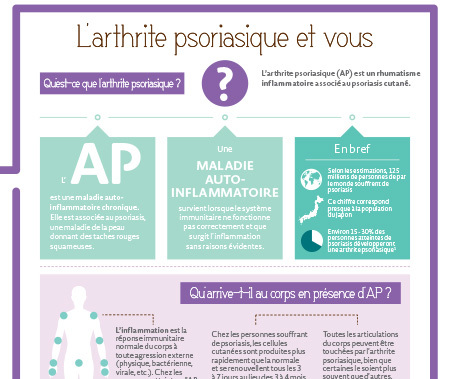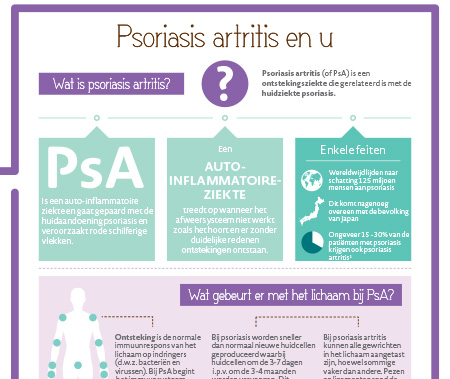Psoriatic Arthritis (PsA)
What is Psoriatic Arthritis?
1. It is a chronic disease.
Psoriatic Arthritis is a long-term condition that cannot be cured. However, the disease can be controlled with proper education and appropriate treatment, usually given by a rheumatologist1.
2. It is a progressive disease.
Usually this means that the earlier a diagnosis is made, the faster it is possible to slow the progression of joint damage with appropriate drug treatment1.
3. It is an inflammatory disease.
People with Psoriatic Arthritis have painful, stiff, red, or swollen joints that can cause a feeling of warmth in the affected body parts1.
Although Psoriatic Arthritis is a chronic disease, early detection and appropriate treatment can help relieve symptoms and prevent joint damage2.
Who is affected by the disease?
- Psoriatic Arthritis is equally frequent in men and women and usually occurs between the ages of 20 and 501.
- About 1 in 3 patients with psoriasis develop Psoriatic Arthritis3.
- About 4 in 5 patients first have skin complaints (psoriasis) before they develop joint complaints4.
What are the causes of Psoriasis Arthritis?
The cause of Psoriatic Arthritis is unknown. However, we know it's an autoimmune disease, like psoriasis. In a person with psoriasis, the immune system (or immune system) becomes abnormally hyperactive, causing the skin cells to grow too quickly. A similar reaction occurs in a person with Psoriatic Arthritis: the immune system is mistaken and thinks it must defend itself against the joints. This causes inflammation, pain and swelling of the joints¹.
There is a link between the disease and family history¹.
What are the symptoms of Psoriatic Arthritis?
Below you can find a list of Psoriatic Arthritis symptoms and how they may develop in patients with this condition¹:
JOINTS:
- Pain, stiffness, swelling, or abnormally warm feeling in your joints.
- Stiffness in the joints that « worsens » when you rest.
- Morning stiffness that can last half an hour to an hour after getting up.
- Some people show such stiffness in the joints all day long or at night.
Advice : if any of the above symptoms last longer than two weeks, you should consult your doctor. In addition, you should mention that you have noticed red and flaky patches of skin on your skin, or have already been diagnosed with psoriasis if this is the case
SKIN:
- Red and scaly patches that cause itching.
- Sometimes these spots are also covered with white skin flakes.
- The red and flaky patches may be concentrated on certain areas of the skin or they may cover larger areas of the body.
As a reminder, people with psoriasis are at risk of developing psoriatic arthritis. It's important to watch your health and be aware of any stiffness, pain, or inflammation in your joints. Consult your dermatologist or your primary care physician if you are concerned.
OTHER SYMPTOMS:
- Nails that have pits or dimples (such as a thimble).
- Swelling of the fingers or toes (sausage fingers/toes) – « dactylitis ».
- Heel pain.
- Eye pain, light sensitivity, spots in the field of view or blurred vision caused by an eye infection – “uveitis”.
- Lower back pain.
- Fatigue – an increased concentration of inflammatory cells in the body can lead to decreased energy in people with Psoriatic Arthritis.
Visit spa-online.be to get more information on the disease of PsA, treatment options, supporting groups and the testing on a potential diagnose of PsA.
Patient brochures
Not the time during your consultations to really get to understand the disease’s profound impact into your patient’s everyday life? Discover our podcast series, with stories from patients suffering from rheumatic diseases (RA, SpA) and comments from rheumatologists Dr Mölls and Dr Joos.
- Fitzgerald O. 2013. Psoriatic arthritis. In: Firestein GS et al. Kelley's Textbook of Rheumatology. Philadelphia: Elsevier, 1232-1268.
- Haroon M et al. Ann Rheum Dis. 2015;74(6):1045-1050
- Mease PJ et al. J Am Acad Dermatol. 2013;69(5):729-735.
- Mease PJ et al. Ann Rheum Dis. 2002;61(4):298-304.
AbbVie SA/NV - BE-ABBV-210106 (v2.0) - February 2024



